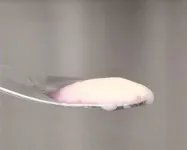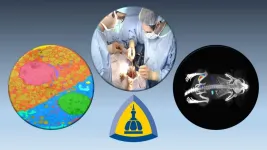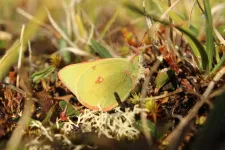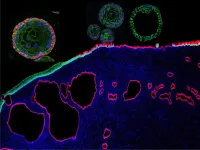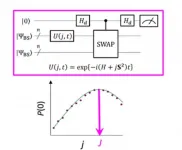Scientists reveal structure of plants' energy generators
The first 3D structure of the components of the mitochondrial electron transport chain in plants reveals unique features that could help in herbicide and pesticide development
2021-01-19
(Press-News.org) Researchers have revealed the first atomic structures of the respiratory apparatus that plants use to generate energy, according to a study published today in eLife.
The 3D structures of these large protein assemblies - the first described for any plant species - are a step towards being able to develop improved herbicides that target plant respiration. They could also aid the development of more effective pesticides, which target the pest's metabolism while avoiding harm to crops.
Most organisms use respiration to harvest energy from food. Plants use photosynthesis to convert sunlight into sugars, and then respiration to break down the sugars into energy. This involves tiny cell components called mitochondria and a set of five protein assemblies that arrange themselves in an 'electron transport train'.
"Knowing how plants convert energy through respiration is a crucial part of understanding how plants grow, how they adapt to changes in the environment and what strategies we can use to improve crop yields," explains first author Maria Maldonado, a postdoctoral fellow at the Department of Molecular and Cellular Biology, University of California, Davis (UC Davis), US. "Yet although the 3D structures of respiration components are well understood in mammals, fungi and bacteria, the technical challenges of gathering pure samples of mitochondrial complexes in plants mean these structures remain largely unknown."
The team set out to obtain 3D structures of three components in the electron transport chain - complex III, complex IV and supercomplex III-IV. They extracted mitochondria complexes from mung bean sprouts treated with a gentle detergent and then stabilised them before using cryo-electron microscopy to generate high-resolution structures. Based on these structures, the team then built atomic models showing how the complexes interact with other molecules, such as other proteins, ions and lipids. For each of the three complexes, they were able to determine the number and structure of subunits, and the likely molecules that bind to them and how flexible the structures are.
Their models showed that several aspects of the complexes are shared between plants, mammals, fungi and bacteria, including several components that were originally thought to exist only in plants. However, the team also found several features of the complexes that are unique to plants, including the way the supercomplex III-IV assembles. This is important, because many agricultural herbicides and pesticides are designed to interfere with the respiratory complexes, and this finding could help to make them more selective for the pests they are intended to kill.
"Our work provides high-resolution structures of plant respiratory complexes that reveal plant-specific features, allowing for the development of more selective inhibitors as herbicides and pesticides," concludes senior author James Letts, Assistant Professor at the Department of Molecular and Cellular Biology, UC Davis, US. "Further comparative analyses of these structures with the growing number of respiratory complexes will allow us to understand the fundamental principles of respiration across the tree of life."
INFORMATION:
Reference
The paper 'Atomic structures of respiratory complex III2, complex IV and supercomplex III2-IV from vascular plants' can be freely accessed online at https://doi.org/10.7554/eLife.62047. Contents, including text, figures and data, are free to reuse under a CC BY 4.0 license.
Media contact
Emily Packer, Media Relations Manager
eLife
e.packer@elifesciences.org
01223 855373
About eLife
eLife is a non-profit organisation created by funders and led by researchers. Our mission is to accelerate discovery by operating a platform for research communication that encourages and recognises the most responsible behaviours. We work across three major areas: publishing, technology and research culture. We aim to publish work of the highest standards and importance in all areas of biology and medicine, including Plant Biology and Structural Biology and Molecular Biophysics, while exploring creative new ways to improve how research is assessed and published. We also invest in open-source technology innovation to modernise the infrastructure for science publishing and improve online tools for sharing, using and interacting with new results. eLife receives financial support and strategic guidance from the Howard Hughes Medical Institute, the Knut and Alice Wallenberg Foundation, the Max Planck Society and Wellcome. Learn more at https://elifesciences.org/about.
To read the latest Plant Biology research published in eLife, visit https://elifesciences.org/subjects/plant-biology.
And for the latest in Structural Biology and Molecular Biophysics, see https://elifesciences.org/subjects/structural-biology-molecular-biophysics.
[Attachments] See images for this press release:
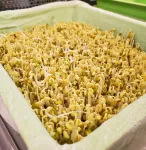
ELSE PRESS RELEASES FROM THIS DATE:
2021-01-19
Provincial and territorial governments should set clear rules for vaccinating health care workers against SARS-CoV-2, the virus that causes COVID-19, in public and private settings, and should not leave this task to employers, according to an analysis in CMAJ (Canadian Medical Association Journal).
"An effective vaccine provided to health care workers will protect both the health workforce and patients, reducing the overall burden of COVID-19 on services and ensuring adequate personnel to administer to people's health needs through the pandemic," writes Dr. Colleen M. Flood, University of Ottawa Research Chair in Health Law & Policy and a ...
2021-01-19
HAMILTON, ON, Jan. 19, 2021 -- McMaster researchers have developed a new form of cultivated meat using a method that promises more natural flavour and texture than other alternatives to traditional meat from animals.
Researchers Ravi Selvaganapathy and Alireza Shahin-Shamsabadi, both of the university's School of Biomedical Engineering, have devised a way to make meat by stacking thin sheets of cultivated muscle and fat cells grown together in a lab setting. The technique is adapted from a method used to grow tissue for human transplants.
The sheets of living cells, each about the thickness of a sheet of printer paper, are first grown in culture and then concentrated on growth plates before being peeled ...
2021-01-19
NANOTECHNOLOGY PREVENTS PREMATURE BIRTH IN MOUSE STUDIES
Media Contact: Rachel Butch, rbutch1@jhmi.edu
In a study in mice and human cells, Johns Hopkins Medicine researchers say that they have developed a tiny, yet effective method for preventing premature birth. The vaginally delivered treatment contains nanosized (billionth of a meter) particles of drugs that easily penetrate the vaginal wall to reach the uterine muscles and prevent them from contracting. If proven effective in humans, the treatment could be one of the only clinical options available to prevent ...
2021-01-19
From a pair of simple principles of evolution--chance mutation and natural selection--nature has constructed an almost unfathomable richness of life around us. Despite our scientific sophistication, human design and engineering have struggled to emulate nature's techniques and her inexhaustible inventiveness. But that may be changing.
In a new perspective article, Stephanie Forrest and Risto Miikkulainen explore a domain known as evolutionary computation (EC), in which aspects of Darwinian evolution are simulated in computer systems.
The study highlights the progress our machines have made in replicating evolutionary processes and what this could mean for engineering design, software refinement, gaming strategy, robotics and even medicine, while fostering a deeper insight ...
2021-01-19
Using cutting-edge DNA sequencing technologies, a group of laboratories in Konstanz, Würzburg, Hamburg and Vienna, led by evolutionary biologist Professor Axel Meyer from the University of Konstanz, succeeded in fully sequencing the genome of the Australian lungfish. The genome, with a total size of more than 43 billion DNA building blocks, is nearly 14 times larger than that of humans and the largest animal genome sequenced to date. Its analysis provides valuable insights into the genetic and developmental evolutionary innovations that made it possible for fish to colonize land. The findings, published online in the journal Nature, expand our understanding of this major evolutionary ...
2021-01-19
Researchers at the University of Helsinki have defined a cancer invasion machinery, which is orchestrated by a frequently mutated cancer gene called Ras. When signaling from Ras protein becomes abnormally high, like it does in many cancers, this switches on the cellular machinery that helps the cancer cells to depart from the tissue from which the cells have developed.
It has been unclear how the cancer invasion machinery works exactly, until now, as the study finds Ras in the role of Friar Lawrence in Shakespeare's famous play, "Get me an iron crow and bring it straight unto my cell (Romeo and Juliet, 5.2.21-23)." ...
2021-01-19
Climate change is more pronounced in the Arctic than anywhere else on the planet, raising concerns about the ability of wildlife to cope with the new conditions. A new study shows that rare insects are declining, suggesting that climatic changes may favour common species.
As part of a new volume of studies on the global insect decline, researchers are presenting the first Arctic insect population trends from a 24-year monitoring record of standardized insect abundance data from North-East Greenland.
The work took place during 1996-2018 as part of the ecosystem-based monitoring program Greenland Ecosystem Monitoring at the field station Zackenberg, located in the world's largest national ...
2021-01-19
Organoids are increasingly being used in biomedical research. These are organ-like structures created in the laboratory that are only a few millimetres in size. Organoids can be used to study life processes and the effect of drugs. Because they closely resemble real organs, they offer several advantages over other cell cultures.
Now there are also organoid models developed for the cervix. This part of the female body is particularly at risk to develop cancers. By creating novel organoid models, a group led by Cindrilla Chumduri (Würzburg), Rajendra Kumar Gurumurthy (Berlin) and Thomas F. Meyer ...
2021-01-19
WHAT:
Healthcare providers must be able to explain the latest data supporting the safety and efficacy of vaccines for coronavirus disease 2019 (COVID-19) so they can strongly encourage vaccination when appropriate while acknowledging that uncertainty and unknowns remain. This message comes from a new commentary co-authored by Anthony S. Fauci, M.D., director of the National Institute of Allergy and Infectious Diseases (NIAID), part of the National Institutes of Health, and other leading NIAID scientists in the journal Annals of Internal Medicine.
The commentary provides an overview of the seven COVID-19 vaccines furthest along in development in the United States. For each vaccine candidate, the authors describe ...
2021-01-19
Understanding how the natural world works enables us to mimic it for the benefit of humankind. Think of how much we rely on batteries. At the core is understanding molecular structures and the behavior of electrons within them. Calculating the energy differences between a molecule's electronic ground and excited spin states helps us understand how to better use that molecule in a variety of chemical, biomedical and industrial applications. We have made much progress in molecules with closed-shell systems, in which electrons are paired up and stable. Open-shell systems, on the ...
LAST 30 PRESS RELEASES:
[Press-News.org] Scientists reveal structure of plants' energy generators
The first 3D structure of the components of the mitochondrial electron transport chain in plants reveals unique features that could help in herbicide and pesticide development

